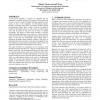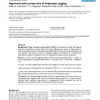245 search results - page 47 / 49 » Locating phase transitions in computationally hard problems |
ACMSE
2006
ACM
13 years 9 months ago
2006
ACM
A code clone represents a sequence of statements that are duplicated in multiple locations of a program. Clones often arise in source code as a result of multiple cut/paste operat...
BMCBI
2006
13 years 7 months ago
2006
Background: Single nucleotide polymorphisms (SNPs) are locations at which the genomic sequences of population members differ. Since these differences are known to follow patterns,...
ISCAS
2006
IEEE
14 years 1 months ago
2006
IEEE
Abstract—We present a silicon neuron with a dynamic, active leak that enables precise spike-timing with respect to a time-varying input signal. Our neuron models the mammalian bu...
UIC
2009
Springer
14 years 2 months ago
2009
Springer
Abstract. In the last years, techniques for activity recognition have attracted increasing attention. Among many applications, a special interest is in the pervasive e-Health domai...
BMCBI
2005
13 years 7 months ago
2005
Background: This paper addresses the problem of recognising DNA cis-regulatory modules which are located far from genes. Experimental procedures for this are slow and costly, and ...


